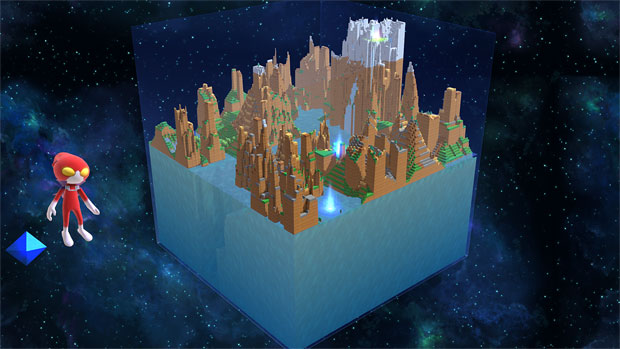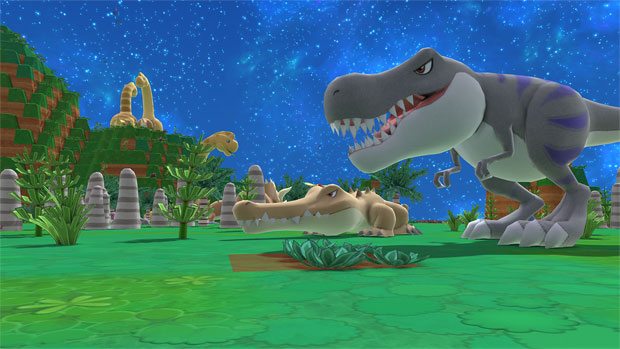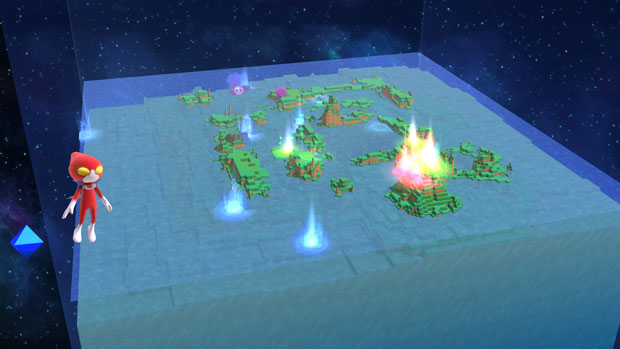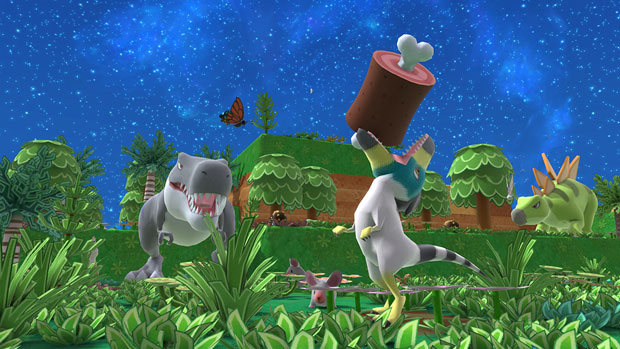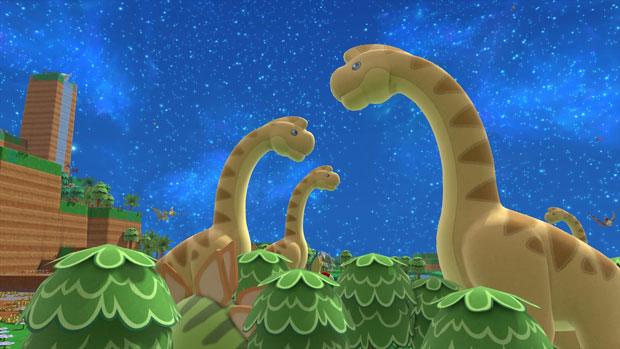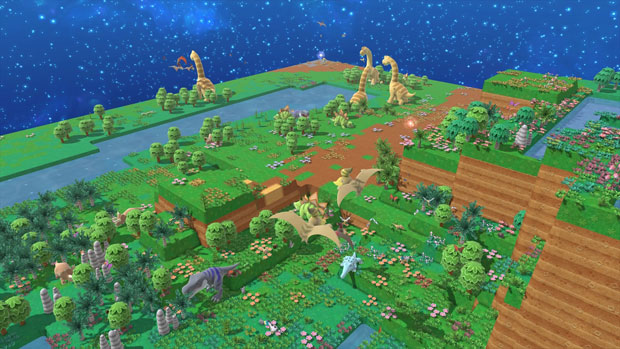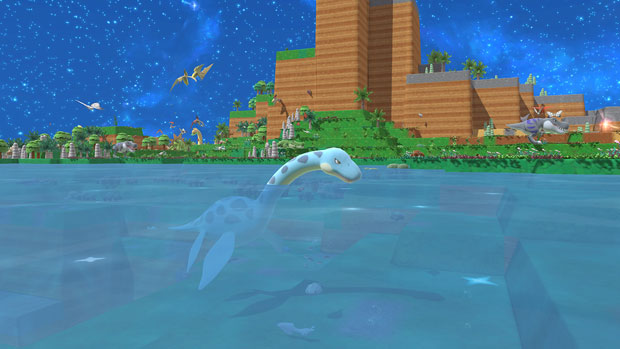Birthdays The Beginning; a new game from Harvest Moon creator Yasuhiro Wada
An adorable evolution playground
Birthdays The Beginning [official site] is a new project, releasing 7 March (that's the NA release, EU will be 10 March), by Harvest Moon creator Yasuhiro Wada. It has been nagging at the edges of my gaming radar for a little while now, simply by dint of game images showing off adorable-looking dinosaurs and pictures of the game as a real-life miniature scene but it was only in the last few days that I learned what the game actually is. It's an environment nurturing sim where you try to spawn and evolve different lifeforms in order to capture them.
Somewhere between Pokemon and Viva Pinata is how I'm thinking of it right now, partly for the gameplay elements, but also for the emotion and the aesthetic of the latter particularly. But to find out more I sat down with Wada-san (and an incredibly helpful translator) as well as tuning in to a Twitch broadcast showing off the main game loops.
So to flesh out the main ideas of Birthdays a little, you manage cubes of land in order to populate them with lifeforms. You'll start small and get to grips with deforming the terrain, raising some parts, lowering others and learning how to create rivers, waterfalls and oceans. There are also items you can collect and use so you'll learn how to spawn, attract and evolve life forms. You start by nudging phytoplankton and zooplankton into being, then start to progress. Stromatolites appear, maybe some cyclomedusa, then a kind of trilobite. You can capture all of these organisms and add them to your library, hence the Pokemon comparison earlier. Wada-san also mentioned Doraemon – a Japanese manga series in which the main character (a robotic cat) has an earthmaker gadget – as one of the inspirations.
In the story mode you have four episodes to gradually work through with the ultimate aim of spawning humans. It's not a story in the sense of a particular narrative – it seems more like a set of guidelines so you have a framework to guide your exploration and capturing. But once that's done you're free to try to complete your library or create biomes according to whatever whims you have left. On-stream the story mode was suggested as taking around 20-30 hours and that would probably fill your database about halfway. Capturing the rest of the creatures was pegged at around the 50-100 hour mark.
There's also a challenge mode which was mentioned on the livestream. That's the more gamey bit with some scoring and time-attack elements. The challenge which was specifically mentioned was for the player to revive a species which had already gone extinct in that particular cube without using items.
The core loop of the game sees you cycling between a micro mode where you zoom in and can manipulate the world, use items, capture lifeforms and so on while time stayed still, and a macro mode where the effects of the changes you've made play out over time and creatures and plants ping in and out of existence. You switch between the two – test and observe, test and observe.
To me, Birthdays seems like a gardening game of a sort – not in that you're growing flowers, but in the sense of nurturing resources and creating a curated ecosystem. I put that as a question to Wada-san to see whether that was how he thought of the project.
"When we hear gardening we picture planting a seed here and placing an animal over here - that's not actually how the game works. The environmental simulation part of your thinking was the more correct. One of the biggest ideas to go away from the gardening aspect was because there have been plenty of games in the past such as Harvest Moon, Hay Day, Farmville... - so we wanted to create something different from those games."
The interaction you have as a player isn't directly with the organisms, except for the capturing and observing you can do. The active involvement is in shaping the land and using those items. Through reworking the terrain you can do things like alter the temperature of the cube. Raising the land brings the overall temperature down and lowering it makes the cube warmer. These changes are a key variable when it comes to making your world inhabitable to particular species. For example, the type of trilobite Wada-san was trying to attack on-stream required a water temperature of 48C and a minimum of 5,400 cyclomedusa to be present in the world.
In our interview he added:
"Let's say we have a map right here and in one area we have a very tall mountain. Naturally, the very tall mountain will become ice-tipped or snow-tipped and on top of the mountain will be polar creatures, but at the same time, on the same map, you can create a very desert, barren area and you could do something like creating dinosaurs there. Since dinosaurs die in the cold in this game we could have two very distinct areas on the map by creating a height difference."
Changing the variables means changing the conditions of the world, and thus forcing lifeforms to adapt or die off as well as attracting new life.
But onto the creatures themselves. I've seen dinosaurs, monkeys, fish, spiders, lizards… a mixture of extinct and current species but no mythical or magical entities yet. I ask whether those are part of the game or whether Birthdays is far more concerned with what's real or historical.
"For the most part, like you said, it's dinosaurs and animals a lot of us are familiar with but there are also UMA category animals. UMA is a term Japanese people use for animals we don't know exist but people think exist, like chupacabras, stuff like that."
Like cryptozoology?
"Yes, I think so. There are some animals in the game that are in that category. UMA is 'Unidentified mysterious animal'. Nothing crazy like dragons but something like chupacabras…" The translator rushes to add, "That's just something I've mentioned, don't quote me but something like that will be in it." So no definite chupacabras but creatures that occupy that folklorish grey area might pop up from time to time.
In terms of the animal interactions, when you zoom in you can see the animals going about their business so you can sort of free-cam around and screenshot to your heart's content but they aren't going to be chasing each other around enacting grisly food chain events. There is a food chain concept in the game, but it's evident in the rise and fall of population numbers on the macro screen.
"You're not going to see a dinosaur chasing after a monkey or something. But there is also the food chain concept in this game, so if there are a lot of herbivores there will naturally be more of their predators - the meat-eaters - but if there's less plant-eaters there's going to be less meat-eaters as well because there will be less food for them. So there's that kind of interaction. It's not a visual interaction but more of a meta interaction."
I was wondering about the name itself. "Birthdays" is very much something I associate with parties – it's an event and a celebration – but it's being used in the more literal sense here.
"We wanted something that everyone in the world is familiar with and it's also fun and something that's very simple. Birthdays is a very familiar concept for most of us. [...] This game is about creation and there's a lot of births which happen in the game which is why we came up with the title 'Birth days'."
He adds, "The official title is Birthdays The Beginning so development for this game is nearly finished. We're almost in the home stretch, but there have been many ideas which were brought up during development of this game which we could have incorporated but we added 'The Beginning' part to show to the world that this is just the beginning and there's more to come with Birthdays."
Essentially, there's one eye on a franchise and on the ideas which didn't quite make the current iteration of the game.
As a final question I ask Wada-san to tell me what he gravitates towards when he plays – any particular biomes or types of creature, perhaps?
"He doesn't really gravitate towards one thing," the translator tells me, "but he's played this game for roughly one thousand hours. [...] There are a lot of sea creatures and there's a mode in the game where you can kind of free roam your map. You could go into the water and check out all the animals in the water. He's like, 'Wow - I can't believe I made something like this'. There's a shark on my right, a small fish to my left, there's a bottom-dwelling fish over there... It's really crazy in the water. He was amazed by that, but the next thing he did was look up out of the water and onto the land and he was able to see the neck of a brontosaurus and beyond that the mountains and the stars in the background. When he saw that he was really happy and he wanted to share his happiness with everybody in the world."
"Are there any octopuses?" I ask (this is my secret last question, asked on the way out because I am videogame sea life Columbo).
"We have squids instead. Also there's a UMA version of the squid."
And with that we conclude the interview. I'm sad about the game's sudden octopus-less-ness BUT there is now the promise of a mythic squid as a silver lining – perhaps a Kraken? Krakens are Relevant To My Interests. I guess I will be conducting my sea life investigations for real in March next year.


